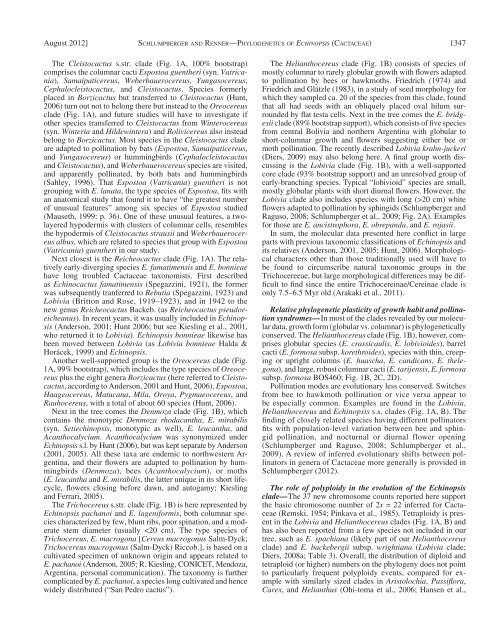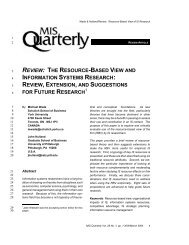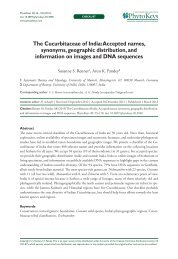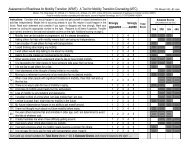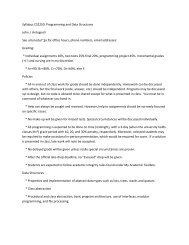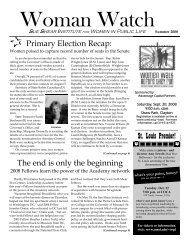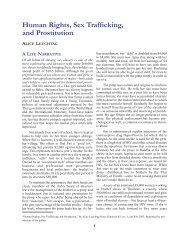molecular phylogenetics of echinopsis (cactaceae)
molecular phylogenetics of echinopsis (cactaceae)
molecular phylogenetics of echinopsis (cactaceae)
You also want an ePaper? Increase the reach of your titles
YUMPU automatically turns print PDFs into web optimized ePapers that Google loves.
August 2012] SCHLUMPBERGER AND RENNER—PHYLOGENETICS OF ECHINOPSIS (CACTACEAE)<br />
The Cleistocactus s.str. clade ( Fig. 1A , 100% bootstrap)<br />
comprises the columnar cacti Espostoa guentheri (syn. Vatricania<br />
), Samaipaticereus , Weberbauerocereus , Yungasocereus ,<br />
Cepha l ocleistocactus, and Cleistocactus . Species formerly<br />
placed in Borzicactus but transferred to Cleistocactus ( Hunt,<br />
2006 ) turn out not to belong there but instead to the Oreocereus<br />
clade ( Fig. 1A ), and future studies will have to investigate if<br />
other species transferred to Cleistocactus from Winterocereus<br />
(syn. Winteria and Hildewintera ) and Bolivicereus also instead<br />
belong to Borzicactus . Most species in the Cleistocactus clade<br />
are adapted to pollination by bats ( Espostoa , Samaipaticereus ,<br />
and Yungasocereus ) or hummingbirds ( Cephalocleistocactus<br />
and Cleistocactus ), and Weberbauerocereus species are visited,<br />
and apparently pollinated, by both bats and hummingbirds<br />
( Sahley, 1996 ). That Espostoa ( Vatricania ) guentheri is not<br />
grouping with E . lanata , the type species <strong>of</strong> Espostoa , fi ts with<br />
an anatomical study that found it to have “the greatest number<br />
<strong>of</strong> unusual features” among six species <strong>of</strong> Espostoa studied<br />
( Mauseth, 1999 : p. 36). One <strong>of</strong> these unusual features, a twolayered<br />
hypodermis with clusters <strong>of</strong> columnar cells, resembles<br />
the hypodermis <strong>of</strong> Cleistocactus strausii and Weberbauerocereus<br />
albus , which are related to species that group with Espostoa<br />
( Vatricania ) guentheri in our study.<br />
Next closest is the Reicheocactus clade ( Fig. 1A ). The relatively<br />
early-diverging species E. famatimensis and E. bonnieae<br />
have long troubled Cactaceae taxonomists. First described<br />
as Echinocactus famatimensis ( Spegazzini, 1921 ), the former<br />
was subsequently tranferred to Rebutia ( Spegazzini, 1923 ) and<br />
Lobivia ( Britton and Rose, 1919–1923 ), and in 1942 to the<br />
new genus Reicheocactus Backeb. (as Reicheocactus pseudoreicheanus<br />
). In recent years, it was usually included in Echinopsis<br />
( Anderson, 2001 ; Hunt 2006 ; but see Kiesling et al., 2001 ,<br />
who returned it to Lobivia ). Echinopsis bonnieae likewise has<br />
been moved between Lobivia (as Lobivia bonnieae Halda &<br />
Horácek, 1999 ) and Echinopsis .<br />
Another well-supported group is the Oreocereus clade ( Fig.<br />
1A , 99% bootstrap), which includes the type species <strong>of</strong> Oreocereus<br />
plus the eight genera Borzicactus (here referred to Cleistocactus<br />
, according to Anderson, 2001 and Hunt, 2006 ), Espostoa ,<br />
Haageocereus , Matucana , Mila , Oroya , Pygmaeocereus , and<br />
Rauhocereus , with a total <strong>of</strong> about 60 species ( Hunt, 2006 ).<br />
Next in the tree comes the Denmoza clade ( Fig. 1B ), which<br />
contains the monotypic Denmoza rhodacantha , E. mirabilis<br />
(syn. Seti<strong>echinopsis</strong> , monotypic as well), E. leucantha , and<br />
Acanthocalycium . Acanthocalycium was synonymized under<br />
Echinopsis s.l. by Hunt (2006) , but was kept separate by Anderson<br />
(2001 , 2005 ). All these taxa are endemic to northwestern Argentina,<br />
and their fl owers are adapted to pollination by hummingbirds<br />
( Denmoza ), bees ( Acanthocalycium ), or moths<br />
( E. leucantha and E. mirabilis , the latter unique in its short lifecycle,<br />
fl owers closing before dawn, and autogamy; Kiesling<br />
and Ferrari, 2005 ).<br />
The Trichocereus s.str. clade ( Fig. 1B ) is here represented by<br />
Echinopsis pachanoi and E. lageniformis , both columnar species<br />
characterized by few, blunt ribs, poor spination, and a moderate<br />
stem diameter (usually 20 cm) white<br />
fl owers adapted to pollination by sphingids ( Schlumpberger and<br />
Raguso, 2008 ; Schlumpberger et al., 2009 ; Fig. 2A ). Examples<br />
for those are E. ancistrophora , E. obrepanda , and E. rojasii .<br />
In sum, the <strong>molecular</strong> data presented here confl ict in large<br />
parts with previous taxonomic classifi cations <strong>of</strong> Echinopsis and<br />
its relatives ( Anderson, 2001 , 2005 ; Hunt, 2006 ). Morphological<br />
characters other than those traditionally used will have to<br />
be found to circumscribe natural taxonomic groups in the<br />
Trichocereeae, but large morphological differences may be diffi<br />
cult to fi nd since the entire Trichocereinae/Cereinae clade is<br />
only 7.5–6.5 Myr old ( Arakaki et al., 2011 ).<br />
Relative phylogenetic plasticity <strong>of</strong> growth habit and pollination<br />
syndromes — In most <strong>of</strong> the clades revealed by our <strong>molecular</strong><br />
data, growth form (globular vs. columnar) is phylogenetically<br />
conserved. The Helianthocereus clade ( Fig. 1B ), however, comprises<br />
globular species ( E. crassicaulis , E. lobivioides ), barrel<br />
cacti ( E. formosa subsp. korethroides ), species with thin, creeping<br />
or upright columns ( E. huascha , E. candicans , E. thelegona<br />
), and large, robust columnar cacti ( E. tarijensis , E. formosa<br />
subsp. formosa BOS460; Fig. 1B, 2C, 2D ).<br />
Pollination modes are evolutionary less conserved. Switches<br />
from bee to hawkmoth pollination or vice versa appear to<br />
be especially common. Examples are found in the Lobivia ,<br />
Helianthocereus and Echinopsis s.s. clades ( Fig. 1A, B ). The<br />
fi nding <strong>of</strong> closely related species having different pollinators<br />
fi ts with population-level variation between bee and sphingid<br />
pollination, and nocturnal or diurnal flower opening<br />
( Schlumpberger and Raguso, 2008 ; Schlumpberger et al.,<br />
2009 ). A review <strong>of</strong> inferred evolutionary shifts between pollinators<br />
in genera <strong>of</strong> Cactaceae more generally is provided in<br />
Schlumpberger (2012) .<br />
The role <strong>of</strong> polyploidy in the evolution <strong>of</strong> the Echinopsis<br />
clade — The 37 new chromosome counts reported here support<br />
the basic chromosome number <strong>of</strong> 2 x = 22 inferred for Cactaceae<br />
( Remski, 1954 ; Pinkava et al., 1985 ). Tetraploidy is present<br />
in the Lobivia and Helianthocereus clades ( Fig. 1A, B ) and<br />
has also been reported from a few species not included in our<br />
tree, such as E. spachiana (likely part <strong>of</strong> our Helianthocereus<br />
clade) and E. backebergii subsp. wrightiana ( Lobivia clade;<br />
Diers, 2008a ; Table 3 ). Overall, the distribution <strong>of</strong> diploid and<br />
tetraploid (or higher) numbers on the phylogeny does not point<br />
to particularly frequent polyploidy events, compared for example<br />
with similarly sized clades in Aristolochia , Passifl ora ,<br />
Carex , and Helianthus ( Ohi-toma et al., 2006 ; Hansen et al.,


